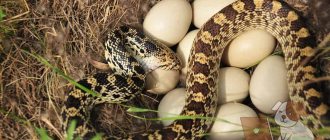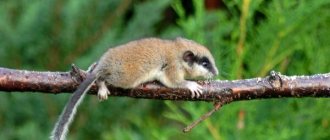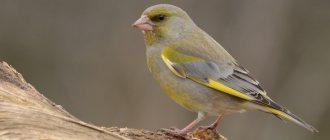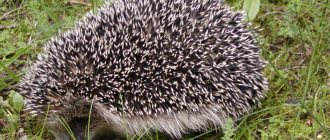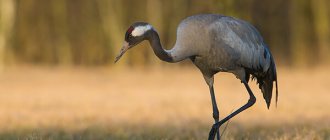Sometimes you can hear the expression: “it’s not a snake, because it’s not poisonous.” Of course, this is completely wrong. More than 3 thousand species of snakes live on earth, divided into 12 families. The largest family, including more than 60% of all species of snakes known to science, is precisely the snake family. And our hero is an ordinary snake, a truly harmless and harmless snake to humans. You can learn about what snakes look like, where and how they live in their natural habitat, as well as how to keep this snake in a home terrarium by reading this article.
Origin of the species and description
The extensive family of colubrids includes as many as two-thirds of all snakes that inhabit the globe. It is not difficult to guess that the ordinary one is also one of the representatives of this snake clan. This reptile is not poisonous, therefore it is completely safe for humans.
People often mistake a snake for a dangerous viper, but there are a number of significant differences between them:
- bright spots on the back of the head indicate that in front of you;
- the body of the snake is more graceful - it is slender and has greater length than the viper;
- snakes differ in the shape of their heads; in a snake it resembles an oval, and in a viper it resembles a triangle;
- Naturally, snakes do not have poisonous fangs (but you won’t notice this right away);
- The pupils of snakes are located vertically (like those of cats), and in the viper they look like transverse rods.
If you go deeper, you can find many more distinctive features, but all of them will not be noticeable to the average person and will not play any role when meeting this or that reptile.
Video: Common snake
People have known them for a long time; before, they were even specially kept as pets, because they cope with annoying mice just as well as cats. Since ancient times, Ukrainians believed that harm caused to snakes brings bad luck to the offender, so these snakes were never offended or driven out of farmsteads.
Interesting fact: He is so popular that there is even a Ukrainian city named after him, this is Uzhgorod, located in the west of the country.
How to distinguish a snake from a viper - the main signs
In fact, the viper and the snake have quite a lot of differences, but an inexperienced nature lover may not be aware of them, which puts their safety into question. Below we will describe all the main differences between these two types of snakes.
Eyes
The most important and noticeable difference between these snakes is their eyes.
- Vipers have vertical pupils that look like slits in the eyes.
- Snakes have round pupils.
On the left is a viper (vertical pupils), on the right is a grass snake (round pupils)
Snakes do not see very well, but they sense what is happening around them thanks to vibrations.
Teeth
Vipers have a pair of long, movable, poisonous fangs, which they show by hissing when in danger and aggression. Non-venomous snakes do not have such teeth; they only have a row of small sharp teeth.
On the left is a viper (two large poisonous fangs), on the right is a grass snake (no fangs)
However, you should not rely too much on this factor, since the viper may not immediately show its teeth and move them to a fighting position.
Head
The viper's large head is noticeably different from the rest of the body. It is flat, the end is rounded, sharp in shape.
The head of snakes is smaller than the head of vipers and is not so pronounced. It is round in shape, without sharp transitions and smoothly blends into the body.
On the left is the head of a viper, on the right is a snake
Unlike the viper, the common grass snake often has yellow, orange, or simply light “ears” on the sides of its head. But sometimes these spots are not visible: they either blend in with the body color or are absent. The water snake does not have these spots, but has a dark spot in the shape of the letter V at the transition from the head to the body.
Already with “ears”
Back pattern and color
Although these two families of snakes are similar in appearance, their colors are different.
- The viper can be brown or brown, black, gray, with a copper or reddish tint. White dots or spots are often visible on its belly. The belly itself is gray, black or brown.
The viper is characterized by a pattern on its back in the form of a zigzag (sometimes diamond-shaped) along the entire spine, which is usually darker than the main color. But such a zigzag pattern is clearly visible only in young individuals; adults have it, but it is not so prominent.
- The coloring is already varied. Most often, its back is olive, but it can also be emerald, brown, brown, black, ash or gray, with a chocolate, red or copper tint. Snakes do not have the pattern on their backs that is characteristic of a viper.
Comparison of the color of a viper and a grass snake
Water snakes have a pattern on their backs in the form of square spots in a checkerboard pattern. If the snake is dark, these spots are not visible. This pattern can be confused with the zigzag of a viper, but if you look closely, these are still separate spots, practically not connected to each other and covering the back not only along the spine, but over its entire surface.
On the left is a viper (a characteristic zigzag pattern along the spine), on the right is a grass snake (checkerboard spots all over the back)
Body
The viper's body is fuller and shorter than that of the snake. The adult has a narrow head and a narrow tail, and is usually much thicker in the center of its length. The body of snakes is more “smooth”, no sharp transitions in thickness are visible, the size of the head is approximately equal to the body or slightly smaller.
Vipers are usually 60-70 cm in length. Snakes are larger, most often individuals are about a meter long, sometimes reaching 2-2.5 m. Small snakes are often found, from 15-20 cm.
On the left is a viper (the head and tail are noticeably narrower than the body), on the right is a grass snake (the thickness of the entire body is approximately the same, gradually decreasing towards the tail)
Tail
The tip of the viper's tail sometimes differs in color from the main body and is red, orange and yellow. The viper's tail itself is shorter than that of the snake, and extends sharply from the body. The grass snake has a long tail, and the transition from its body to the tail is smooth.
On the left is the tail of a viper (short, “triangular”), on the right is the tail of a grass snake (long, gradually tapering)
Habitat
- The viper adapts to almost all natural conditions. She masters different terrains. It is found in mountains, wastelands, fields, swamps and meadows, on the banks of reservoirs and rivers.
The viper rarely moves more than 100-150 meters from its shelter. Only during wintering does it move about 2 km to the place where the snake is going to wait out the cold (depressions up to 2-3 meters). Wintering, depending on the climate, occurs from October to April.
The viper can live almost anywhere
While walking in a place where a viper can live, it is found in crevices, in bushes and tall grass, under stumps. Sometimes it is visible in open areas when basking in the sun.
- Common snakes are found in bushes and tall grass near a swamp or pond. They often crawl into gardens. Snakes are completely harmless and should not be killed. Snakes are often even tamed to catch mice.
Water snakes live next to ordinary snakes, but only if there are large reservoirs or rivers nearby.
Snakes live mainly near bodies of water
Nutrition
- Vipers prefer frogs and viviparous lizards. They also eat mice, moles and other rodents. Small vipers can catch worms, butterflies or slugs.
- Snakes eat amphibians (frogs, toads, tadpoles), small birds and their eggs, eggs of lizards, grass snakes and other snakes, mice, rats, moles, squirrels, and sometimes worms and caterpillars.
Water snakes also feed on fish. Therefore, if a snake eats fish, then it is most likely a water snake.
Behavior
Both the viper and the snake are non-aggressive snakes. They attack only in cases of extreme necessity, when something threatens them, and there is no other choice.
Viper is resting
When meeting a person, snakes usually try to crawl away on their own. But snakes can also bite you or throw their body forward to scare you. Sometimes snakes can curl up into a ball and start hissing, trying to scare their opponent, in which case it is better to simply move away to a safe distance. Although the snake’s bite will not be poisonous, it will bring pain, so you should not try to throw it away, much less pick it up - this is a fairly fast snake that can attack sharply, but, again, it does this only in case when he sees no other way out.
Several useful videos on the topic:
Appearance and features
The average length of the snake usually does not exceed one meter, but there are specimens whose length reaches one and a half meters. Previously, a characteristic dinner sign was already noted in the form of two symmetrically located spots, which are located at the transition of the head to the body.
They are bordered by a black outline and can be:
- orange;
- slightly yellowish;
- bright lemon;
- whitish.
Interesting fact: There are ordinary snakes that have no bright spots in the occipital region at all or are very faintly expressed. Among the snakes there are both albinos and melanists.
The dorsal part of the snake can be light gray and dark, almost black, sometimes it has an olive or brownish tint. If the tone is already gray, then spots of dark shades may be noticeable on it. The abdomen of the reptile is light and lined with a black stripe, stretching almost to the chin. The oval head stands out against the background of the body with its graceful neck. The tail of a reptile is 3 to 5 times shorter than its body. Male suppers are much smaller than females.
If we go into a more thorough and in-depth description of the common snake, it is worth noting that its head is covered with fairly large rectangular scutes: parietal, preorbital, postorbital, temporal, upper labial and one frontal. The scales located on the ridge of the reptile are ribbed, and on the sides they are smooth. Around the middle part of the body (in one row) there can be 19, 18 or 17 of them.
Is it really dangerous for humans?
The snakes that live in our latitudes are absolutely harmless to humans. They are not poisonous, and also cannot bite at all; the most they can do is lightly scratch the skin. In addition, when a person approaches, all snakes try to hide as quickly as possible, and they can bite only in extreme cases, if they are driven into a corner. In any case, light scratches caused by snakes heal quickly. Having been caught by a person, he will try to imitate his own death as a defensive reaction, his body will sag and stop moving, but when released into the wild, such a pseudo-dead will quickly come to life and hide in the bushes.
True, there are also types of snakes that can still cause harm, these include the tiger snake or the fisher snake; they have poisonous teeth in the back of the jaw and their bite can cause swelling or even be fatal.
Duration and lifestyle
It lives a long time, from 19 to 23 years, and the main condition for its long life is considered to be water, which is responsible for the scientific name of the species - natrix (from the Latin natans, translated as “swimmer”).
This is interesting! Snakes drink a lot and swim, making long swims without a specific goal. Their route usually runs along the coast, although some individuals have been seen in the open sea and in the center of huge lakes (tens of kilometers from land).
In the water it moves like all snakes, raising its neck vertically and bending its body and tail in a wave-like manner in the horizontal plane. During the hunt, it dives deeply, and when resting, it lies on the bottom or wraps itself around an underwater snag.
It searches for prey in the mornings/evenings, although the peak of activity occurs during daylight hours. On a clear day, the common snake exposes its sides to the sun on a stump, stone, hummock, fallen trunk or any convenient elevation. At night it crawls into shelter - voids from uprooted roots, accumulations of stones or holes.
Social structure and reproduction
Photo: Common snake
Common snakes become sexually mature at three or four years of age. Their wedding season begins after the first spring molt; the time frame may vary in different regions, but usually it occurs at the end of April-May. In snakes, mating games are possible in the fall, but then egg laying is postponed until spring.
Before mating, snakes intertwine in the form of a ball, consisting of one female and many of her gentlemen. When the fertilization process is completed, the female moves on to the next stage - laying eggs.
Snake eggs are leathery; one female can lay from several to 100 eggs. It is necessary that they (the eggs) do not freeze or dry out, so the snake chooses a place that is both warm and moist, for example, rotten leaves, an impressive moss litter, or a rotten stump. The location is chosen very carefully, because... The female does not incubate, leaving her clutch behind.
Interesting fact: Female snakes can combine their clacks if suitable places for separate ones cannot be found. In a forest clearing, people discovered a nest where they counted 1,200 eggs.
After five or eight weeks, the constrictors begin to hatch, the length of which is from 11 to 15 cm. From birth, they begin to look for a place for a safe wintering. Not all babies have time to accumulate fat before the onset of autumn cold, but even the most poorly nourished ones still survive until spring, only they look a little smaller than their well-fed counterparts.
Interesting fact: It is estimated that every fiftieth baby snake is born with two heads, that’s how nature decides. Only such “Gorynych snakes” do not live long.
Snakes can be considered long-livers; their life span often exceeds twenty years; on average, these reptiles live from 19 to 23 years. The main condition for their longevity is the presence of a life-giving water source near their places of permanent deployment.
Enemies of the common snake
If the snake does not hide before sunset, it will quickly cool down and will not be able to quickly escape from natural enemies, among which are:
- carnivorous mammals including fox, raccoon dog, weasel and hedgehog;
- 40 species of large birds (for example, storks and herons);
- rodents, including rats;
- amphibians such as frogs and toads;
- trout (eats young fish);
- ground beetles and ants (destroy eggs).
Trying to instill fear in the enemy, the snake hisses and flattens the neck area (pretending to be a poisonous snake), folds its body in a zigzag and nervously twitches the end of its tail. The second option is to run away.
This is interesting! Finding itself in the paws of a predator or the hands of a person, the reptile pretends to be dead or splashes itself with a stinking substance secreted by the cloacal glands.
Snakes constantly experience a shortage of reliable shelters, which is why they happily take advantage of the fruits of human activity, inhabiting houses, chicken coops, bathhouses, cellars, bridges, sheds, compost heaps and garbage dumps
Diet in nature - what does an ordinary person eat?
The gastronomic preferences of the snake are quite monotonous - frogs and fish . Periodically, it includes other prey of suitable size in its diet. It can be:
- newts;
- toads;
- lizards;
- chicks (fallen out of the nest);
- newborn water rats;
- insects and their larvae.
Snakes disdain carrion and do not eat plants, but they willingly drink milk when they are in a terrarium
This is interesting! There is a known case when a forced hunger strike lasted 10 months. He was subjected to this test by a German naturalist who did not feed the experimental subject from June to April. The first feeding of the snake after the hunger strike passed without any deviations from the gastrointestinal tract.
Snake breeding
Puberty occurs at 3-4 years. The mating season lasts from April to May, egg laying occurs in July-August . The mating periods in different regions may not coincide, but they always begin after the end of the first seasonal molting (it usually changes its skin after catching and digesting the first prey). Cases of autumn mating have been recorded, when the female lays eggs after wintering.
Coitus is preceded by the intertwining of several snakes (a female and many males) into a “nuptial ball”, which results in the laying of leathery eggs in quantities ranging from a few to 100 (and even more).
This is interesting! If there are not enough secluded places in the population’s habitat, females create a collective storage of eggs. Eyewitnesses told how they once found a clutch of 1,200 eggs in a forest clearing (under an old door).
The masonry must be protected from drying out and cold, for which the snake seeks out a moist and warm “incubator”, which often becomes a pile of rotten leaves, a thick layer of moss or a rotten stump.
Having laid eggs, the female does not hatch the offspring, leaving them to the mercy of fate. After 5-8 weeks, small cones are born, 11 to 15 cm long, and from the moment of birth they are preoccupied with finding a place to winter.
Habitats of the tiger snake
The tiger snake sticks to wet habitats. Selects areas close to swamps, ponds, wet lowlands with thick grass cover. In the absence of water bodies, it inhabits deciduous and mixed forests, as well as damp meadows. In such areas this reptile species is quite numerous and widespread; On a permanent 3 km route, up to 44 individuals are caught.
In defense, the brindle snake takes a characteristic pose.
Wintering
Snakes leave for the winter in October-November. These snakes use deep rodent burrows, various crevices and voids under roots and stumps as wintering shelters. They winter together in groups of several individuals or alone. They emerge from hibernation in April, when warm weather sets in. At first they are not very active, they lie for a long time and bask in the sun. And after the first spring molt, the mating season begins. At this time, they gather in groups of several individuals (males and females), forming balls.
Where and how do snakes winter?
Since snakes are cold-blooded creatures, they feel comfortable only in hot climates. Snakes become inactive and begin to prepare for hibernation in the fall, when the temperature begins to gradually decrease. Even before the onset of winter, they fall into suspended animation. So they survive the cold without moving and wait for the climate to become hot again.
Snakes are great at climbing trees
They come out of hibernation in the spring, and not in a specific month, but when the temperature becomes favorable for this. In fact, suspended animation in snakes lasts for a different period of time every year, which depends on the onset of frost and its end. The snake will not stop activity in advance, and will continue to lead its usual way of life until the end. The same applies to coming out of hibernation. As soon as it becomes warm enough, the individual will immediately come to life.
For wintering, snakes look for places where winter frosts will not reach. They are not afraid of low temperatures, but as a den, individuals choose a corner where the temperature during the cold weather will be as high as possible. Moreover, several individuals can be hibernating in one place at once.
Interesting fact : there have been cases when in winter people found snake dens for hibernation, inside which there were 40-60 snakes.
If other species of snakes live in the surrounding areas, they may join the snakes during hibernation. Since it is sometimes difficult to find places with suitable conditions, the animals cooperate and share one den for all.
When winter ends, cold-blooded creatures crawl out of their shelter to the surface. It takes them a couple of days to even out their body temperature and become active. Having basked enough in the sun, the snakes become mobile, return to their territories and begin hunting.
Keeping a common grass snake in a terrarium
In captivity, snakes quickly get used to human hands, stop making attempts to bite, and secrete protective fluid.
Arrangement of the terrarium
An ordinary grass snake can be kept in a horizontal terrarium, the minimum size of which should be 50x40x40 cm, but larger is better. To prevent the snake from escaping, the top of the terrarium is covered with a net.
A mandatory attribute in a terrarium for a snake is a pool in which the pet can swim.
In the warmest corner of the terrarium, the temperature should be 30-33°C during the day and 20-23°C at night. The desired temperature is maintained by a lamp, thermal cord or thermal mat.
Coconut substrate, gravel, coarse sand, sphagnum moss or just paper are used as bedding. Humidity must be maintained at a high level, which is achieved by regularly spraying the soil with a spray bottle. The snake is a diurnal snake, so the lighting should be bright enough (fluorescent or LED lamps). Be sure to place shelters (for example, pieces of bark) in warm and cold corners.
Plants will create additional shelter, but you need to keep in mind that most snakes quickly break and spoil the plants of the terrarium, so it is better to decorate the snake’s home with branches, snags, etc. And plants can only be placed in ampelous forms, fixed at the top of the terrarium and hanging down. Or use tough plants - monstera, aspidistra, sansevieria, bromeliads, etc.
Communication with a snake
When communicating with this pet, hand movements should be leisurely and smooth. Sharp, quick gestures should not be allowed; the snake responds to such movements with a throw.
If you need to take a calmly lying snake, the hand should smoothly approach it from behind, along the back to the head. You need to take it by the neck, behind the head. The grip should be precise, tenacious, but not tight: by squeezing the reptile too tightly, we prevent it from breathing. With your other hand you need to grab the pet’s body close to the tail. Keep in mind that only non-venomous snakes can be taken this way.
What to feed the snake?
The snakes are fed frogs, toads, and baby mice, and the food must be live. Some people believe that a snake can be trained to eat raw meat. Many snakes, especially hungry ones, can sometimes show interest in meat, crawl up to it, feel it with their tongue, but do not eat it. After all, snakes are specialized in hunting moving prey.
So, I already got the frog and ate it. When should I feed him again now? The pet will tell you about this through its behavior. A well-fed pet lies and digests food. When hungry, it begins to restlessly crawl around the terrarium and feel everything with its tongue. This can occur either 3 days after feeding, or after 1-2 weeks, and even after a month. It all depends on the condition of the reptile, the conditions in the terrarium, and the amount of food eaten previously. In winter, snakes eat less often. But sometimes the snake may completely refuse to eat. If this has not been observed in your pet before and he ate well in the terrarium, then there are 2 reasons why he refuses food:
- is already sick or so weak that he has no time to eat;
- He is already healthy, well-fed, but physiologically needs some rest for some time, does not want to eat.
Of course, the second case should not be a cause for concern. But how can one determine the health and fatness of a snake? So, a healthy snake has clean nostrils and eyes, a pink mouth, a mobile and fast tongue, and appears during periods of excitement. When molting, a healthy reptile leaves an almost untorn film of skin - crawling. A sick snake sheds in patches (snakes can also shed if there is a lack of moisture).
The fatness of a snake can be determined externally and by touch: the reptile should be round, the vertebrae should not protrude, it is difficult to feel with a finger.
Severely emaciated and sick animals usually lie stretched out, the body bent in small waves. In this case, you cannot do without the help of a herpetologist.
How do snakes reproduce?
The main part of snakes reproduces by laying eggs. Some species, such as American grass snakes, are ovoviviparous. And in some species the rudiments of viviparity are observed (for example, in the species Thamnophis sirtalis).
Photo credit: Dawson, CC BY-SA 2.5
Males snakes reach sexual maturity at the 3rd year of life, females at the 4th or 5th year. There are snakes that become sexually mature when their body reaches a certain size.
Usually the mating season for snakes begins in the spring. Immediately, or 1-2 weeks after leaving wintering grounds, snakes begin to mate. In common snakes, “courtship” occurs as follows: the male, approaching the female, shakes his head from side to side, then presses tightly against her side or back, rubs against her, and wraps his tail around her. Sometimes several males gather around a female, forming a so-called “nuptial ball.” But the males do not fight among themselves, but only try to interfere with each other. Mating occurs in late April - early May, and snakes lay eggs in late June - early July. If the summer is cold, these dates are shifted to a later time.
In some species, mating occurs in the fall. This is typical, for example, for water snakes. In this case, the female lays fertilized eggs next summer.
Snake eggs are covered with a white leathery film consisting of microscopic fibers soaked in sticky protein. They can have different shapes: oblong, round, pear-shaped. The sizes of eggs and clutches vary, depending on the type of snake, age and length of the female. Clutches are often “collective” and can number up to 1000 eggs.
Photo credit: Georg Wilhelm, CC BY-SA 3.0
To lay eggs, snakes use secluded warm and damp places: heaps of humus, old straw, fallen leaves, rotten stumps, damp moss, loose litter under stones. The incubation period lasts 1-2 months. The embryo goes through the initial stages of development in the mother's body. The snake hatches from the egg using a special egg tooth, which makes cuts in the shell. The length of the newborn constriction varies among different species of snakes. Newborns immediately crawl away and lead an independent lifestyle.
Photo by: Lenka Macková
Photo credit: stevenbolgartersnakes.com
Population and species status
The extensive colubrid family inhabits almost all continents. In general, the population of these peaceful reptiles does not experience any threats and does not cause any great concern about decline. The conservation status of snakes can be considered normal. Recently, no sharp, widespread decline in the number of these snakes has been noticed.
As for our country, common snakes can be called one of the most common reptiles that thrive in a variety of natural areas, including anthropogenic ones. Despite the fact that the situation with the state of the common grass snake population is favorable almost everywhere, there are regions where its numbers have decreased significantly and it was included in the Red Book of certain regions. This situation arises, first of all, due to the rapid human activity, which is often selfish and aimed only at the benefit of the people themselves, completely ignoring the interests and needs of our smaller brothers.
So that he no longer needs protection and continues to delight us with his large numbers, it is necessary, first of all, not to barbarically invade the places of his permanent residence, to preserve secluded and reliable places for wintering and laying, to think in advance about decisions regarding any construction, including laying new highways. The main thing is not to lose humanity and show care.
Conservation of common grass snakes
As mentioned earlier, not everywhere the situation for the life activity and development of snakes is favorable, therefore in some regions the common snake needs protection. For the purpose of protection, it is listed in the Red Book of some regions: Moscow, Tver, Leningrad. It is also protected in the Republic of Karelia. In all of these listed places, the reptile population has sharply declined, although previously they were numerous.
The reason for this can be attributed to the following unfavorable factors:
- deterioration of the environmental situation;
- severe pollution of all kinds of water bodies (water is vital for snakes);
- lack of space for successful living and laying eggs;
- displacement of snakes by humans from their places of permanent residence, as a result of plowing land, building roads, cities, etc.
In those regions where the common grass snake is listed in the Red Book, the status of its species is designated as vulnerable and declining in number. In the regions, programs are being developed to restore the number of snakes in the territories of special, protected, and protected areas. On river banks, people recreate near-water flora; special permitted places are allocated for mass swimming and recreation in such areas.
In conclusion, I would like to add that you are always surprised at how much you can learn about a seemingly familiar and well-known ordinary creature from childhood, about which people have created many legends and beliefs since ancient times, where the ordinary one acts as a symbol of good luck, the keeper of countless riches and treasures and even the ruler of other reptiles.
Interesting facts about snakes
- Snakes sometimes experience such a mutation that two-headed individuals are born. True, such unusual snakes do not live long.
- There are many tales about snakes in folklore, for example, that snakes allegedly hypnotize frogs before eating them. In fact, this is nothing more than fiction.
- Snakes are frequent heroes of many folk tales, in which they often act as guardians of treasures and treasures.
ROYAL SNAKE: DESCRIPTION, REPRODUCTION, PHOTO, POISON, BEHAVIOR
MILK SNAKE: DESCRIPTION, CARE, REPRODUCTION, PHOTO, TYPES
TURTLE: PHOTO, DESCRIPTION, CARE AT HOME
Where do snakes live?
Snakes choose to live in areas where there is a large amount of water and a high level of humidity. They settle in mountainous areas, near lakes, rivers, and ponds. Snakes are found in Europe, where they are found almost everywhere with the exception of areas with low temperatures (the area near the Arctic Circle).
In addition, some varieties can be found in different parts of Africa. The exception is extremely arid areas in which the humidity level does not correspond to the desired climatic norms. However, certain species of snakes prefer sandy soil and a dry climate to swamps and damp areas.
Snakes are considered first-class swimmers and divers. They are able to stay under water for a long time.
Some species of reptiles are found on the Japanese and Philippine islands. Snakes can be seen in Asia and Australia. In Russia, snakes are found almost everywhere.
The Colubrida family is quite extensive. It also includes burrowing snakes that prefer to live in forested areas. Their shelter is rocks, fallen leaves, and gorges, where they spend time if they do not need to go hunting. And, for example, sharp-nosed snakes live right in the soil. They hide in loose soil and throw sand on top of themselves. These reptiles are active exclusively at night; during the day they are almost never seen.
Thus, the habitat of snakes is vast, since it includes not only southern, but even northern latitudes, the territory of which reaches all the way to the Arctic Circle.
Snakes have a high degree of adaptability, which allows them to feel comfortable in different living conditions. To live, they need to be nearby any body of water that contains standing or barely flowing water.
In addition, snakes often settle next to people, choosing urban areas for this. They love to bask in the sun on the asphalt, which is why they often get hit by cars. This habit of snakes has a direct impact on the number of reptiles, especially in densely populated areas. However, on a global scale, this does not affect the decline in the snake population.
